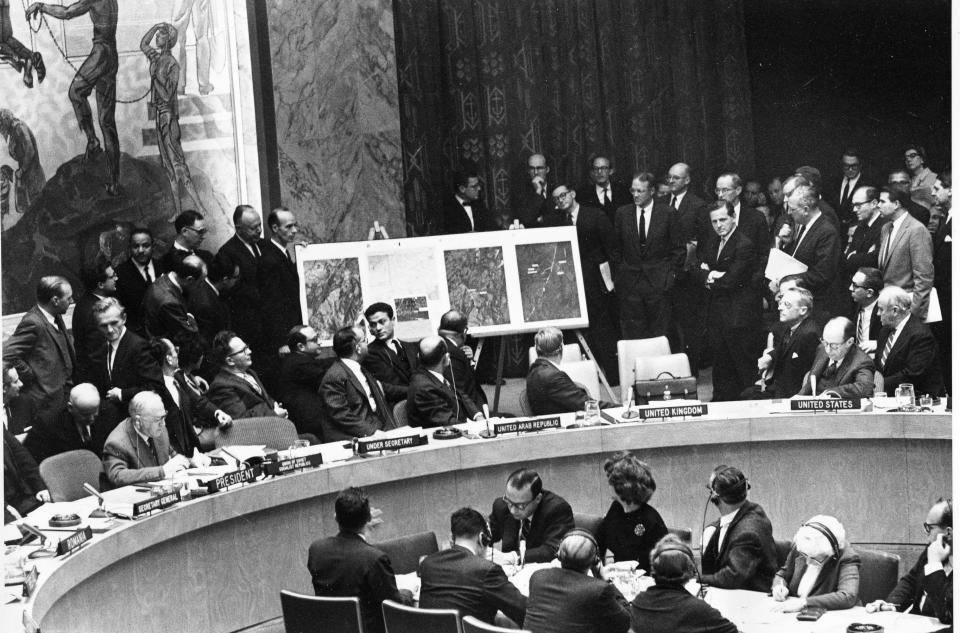Puebloan Lane Maxwell reflects on service during Cuban missile crisis 60 years later
- Oops!Something went wrong.Please try again later.
Underground at the Dyess Air Force Base in Abilene, Texas, on the night of Oct. 23, 1962, Lane Maxwell was unsure if there was still a world above him.
Maxwell, who now resides in Pueblo, was working a 24-hour shift at the base that day during the Cuban missile crisis, a 13-day period in which the United States and Soviet Union teetered on the edge of nuclear war. As one of two officers in a nine-man crew, Maxwell was manning Atlas F missile silos armed with nuclear warheads and prepared to launch on command.
"The night was very tense," Maxwell said. "Normally, we would have messages during the night... This night we were told to maintain radio silence."
Following a botched American attempt to overthrow Fidel Castro's communist government at the Bay of Pigs, Soviet leader Nikita Khrushchev agreed with Castro to install nuclear weapons in Cuba. On Oct. 14, 1962, a U.S. aircraft photographed Soviet nuclear missiles being constructed in Cuba. U.S. President John F. Kennedy announced the findings in a public address two days later, signifying the beginning of the crisis.
More:'Still steaming ahead': Tales of a WWII Marine returned to Pearl Harbor by Pueblo West kin
After graduating high school in Womelsdorf, Pennsylvania, Maxwell enlisted in the U.S. Air Force in 1955. He spent 6½ years as an enlisted airman before receiving a commission to become an officer. As an officer, he was assigned to Dyess Air Force Base, where 12 Atlas F missile silos surrounded a two-story command center like numbers on a clock, Maxwell said.
"If we had pushed a button for the countdown, fuel and an oxidizer would have been loaded on them and all the electronic checks would have been made," Maxwell said. "The next button we'd push would be called 'commit sequence,' in which the missile elevator took it to the surface and then it would automatically launch from there. At any point up until the launch, we could have hit the abort button and stopped the missile from having been fired."
On Oct. 22, 1962, Kennedy called for a naval "quarantine" of ships to prevent Soviet imports of weaponry to Cuba. Kennedy wrote to Khrushchev, informing him of the quarantine and demanding that all missile bases in Cuba be dismantled, according to the U.S. Department of State. Khrushchev's response called Kennedy's quarantine a "blockade" and said Soviet ships would continue heading to Cuba.

While Oct. 23 was a night of radio silence at Dyess Air Force Base, it was expected to be the night American and Soviet ships would confront each other. At 8 a.m. the next day, Maxwell finished his 24-hour shift and was informed that Soviet ships had still not been intercepted. Blocked by American ships, Soviet ships carrying weapons began turning away from Cuba on Oct. 24-25, while Maxwell was catching up on some much-needed sleep.
The Cuban missile crisis would last until Oct. 29, when Khrushchev pledged to remove Soviet missiles from Cuba if the United States abstained from invading Cuba; Kennedy agreed.
Just over 60 years later, Maxwell said the crisis is still a reminder of the responsibility that rests on the shoulders of world leaders.
"Today we are in that same condition. Anybody could push a button and it could lead to nuclear war worldwide ... in those days, we had two leaders who kept cool and calculated the ramifications of their actions," Maxwell said. "I'm not sure that is the case today, but I sure hope so."
Pueblo Chieftain reporter James Bartolo can be reached by email at JBartolo@gannett.com.
This article originally appeared on The Pueblo Chieftain: Puebloan recalls Cuban missile crisis, tense night in a missile silo

